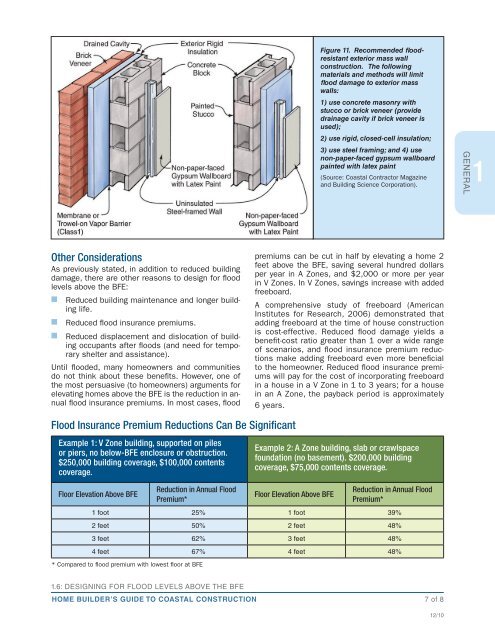FEMA P-499: Home Builder's Guide to Coastal Construction
FEMA P-499: Home Builder's Guide to Coastal Construction
FEMA P-499: Home Builder's Guide to Coastal Construction
You also want an ePaper? Increase the reach of your titles
YUMPU automatically turns print PDFs into web optimized ePapers that Google loves.
Other Considerations<br />
As previously stated, in addition <strong>to</strong> reduced building<br />
damage, there are other reasons <strong>to</strong> design for flood<br />
levels above the BFE:<br />
n Reduced building maintenance and longer building<br />
life.<br />
n Reduced flood insurance premiums.<br />
n Reduced displacement and dislocation of building<br />
occupants after floods (and need for temporary<br />
shelter and assistance).<br />
Until flooded, many homeowners and communities<br />
do not think about these benefits. However, one of<br />
the most persuasive (<strong>to</strong> homeowners) arguments for<br />
elevating homes above the BFE is the reduction in annual<br />
flood insurance premiums. In most cases, flood<br />
Flood Insurance Premium Reductions Can Be Significant<br />
Example 1: V Zone building, supported on piles<br />
or piers, no below-BFE enclosure or obstruction.<br />
$250,000 building coverage, $100,000 contents<br />
coverage.<br />
Floor Elevation Above BFE<br />
Reduction in Annual Flood<br />
Premium*<br />
1.6: DESIGNING FOR FLOOD LEVELS ABOVE THE BFE<br />
Figure 11. Recommended floodresistant<br />
exterior mass wall<br />
construction. The following<br />
materials and methods will limit<br />
flood damage <strong>to</strong> exterior mass<br />
walls:<br />
1) use concrete masonry with<br />
stucco or brick veneer (provide<br />
drainage cavity if brick veneer is<br />
used);<br />
2) use rigid, closed-cell insulation;<br />
3) use steel framing; and 4) use<br />
non-paper-faced gypsum wallboard<br />
painted with latex paint<br />
(Source: <strong>Coastal</strong> Contrac<strong>to</strong>r Magazine<br />
and Building Science Corporation).<br />
premiums can be cut in half by elevating a home 2<br />
feet above the BFE, saving several hundred dollars<br />
per year in A Zones, and $2,000 or more per year<br />
in V Zones. In V Zones, savings increase with added<br />
freeboard.<br />
A comprehensive study of freeboard (American<br />
Institutes for Research, 2006) demonstrated that<br />
adding freeboard at the time of house construction<br />
is cost-effective. Reduced flood damage yields a<br />
benefit-cost ratio greater than 1 over a wide range<br />
of scenarios, and flood insurance premium reductions<br />
make adding freeboard even more beneficial<br />
<strong>to</strong> the homeowner. Reduced flood insurance premiums<br />
will pay for the cost of incorporating freeboard<br />
in a house in a V Zone in 1 <strong>to</strong> 3 years; for a house<br />
in an A Zone, the payback period is approximately<br />
6 years.<br />
Example 2: A Zone building, slab or crawlspace<br />
foundation (no basement). $200,000 building<br />
coverage, $75,000 contents coverage.<br />
Floor Elevation Above BFE<br />
Reduction in Annual Flood<br />
Premium*<br />
1 foot 25% 1 foot 39%<br />
2 feet 50% 2 feet 48%<br />
3 feet 62% 3 feet 48%<br />
4 feet 67% 4 feet 48%<br />
* Compared <strong>to</strong> flood premium with lowest floor at BFE<br />
HOME BUILDER’S GUIDE TO COASTAL CONSTRUCTION 7 of 8<br />
12/10<br />
GENERAL<br />
1


